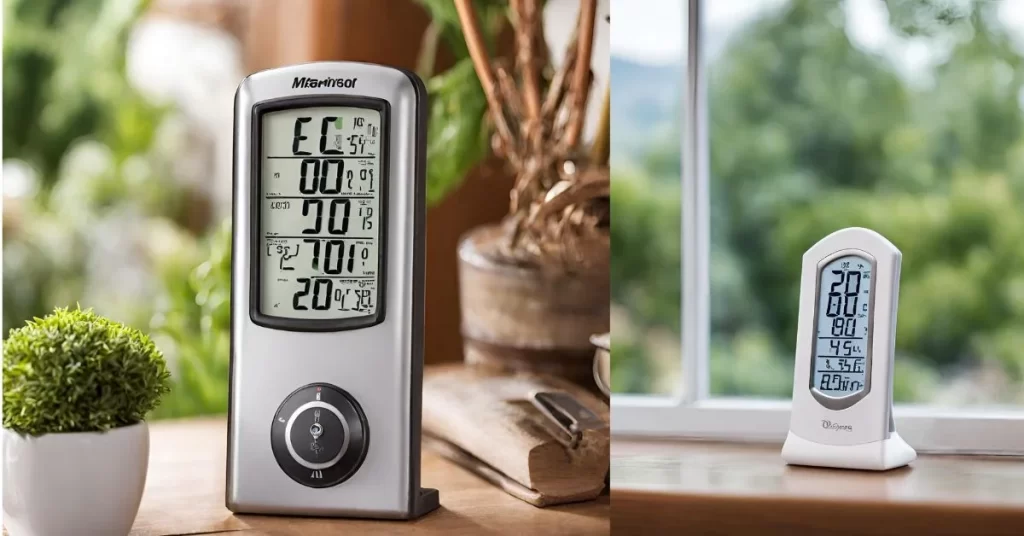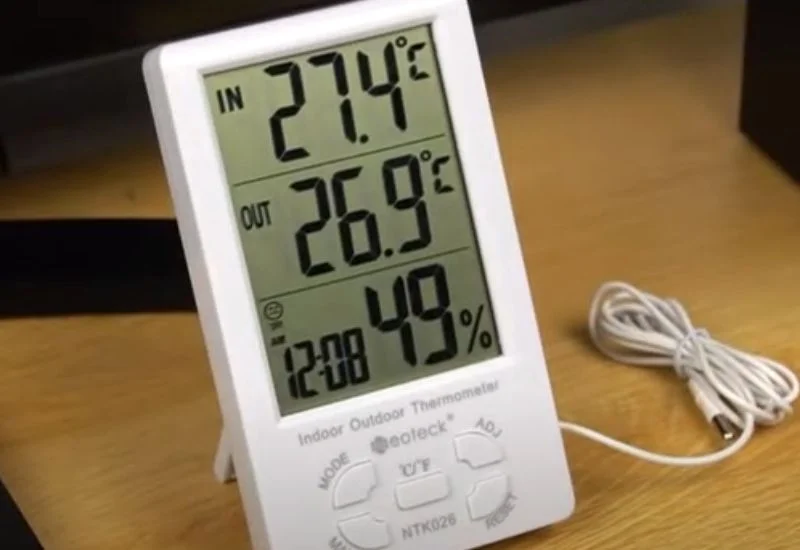Imagine this you wake up on a seemingly mild morning, brew a cup of tea, and settle in for a cosy read. But just as you step outside to enjoy the fresh air, a blast of unexpected chill sends shivers down your spine. Or perhaps, you’ve cranked up the heating only to discover your family is sweltering in their pyjamas. These scenarios, while relatable, are easily avoidable with a simple yet ingenious tool the indoor outdoor thermometer.
What is Indoor Outdoor Thermometer ?

An indoor outdoor thermometer, as the name suggests, is a multi-tasking marvel that displays both the temperature inside your home and the surrounding outdoor environment. Typically featuring a digital display, it eliminates the need for separate thermometers, simplifying your life and saving you precious time.
Why one Should use an Indoor Outdoor Thermometer?
Here’s why incorporating this clever gadget into your home is a wise decision:
1. Enhanced Comfort:
Knowing both indoor and outdoor temperatures empowers you to adjust your thermostat accordingly. This ensures a comfortable and energy-efficient environment for everyone, especially during seasonal transitions when the weather can be unpredictable.
2. Informed Clothing Choices:
Stepping outside in inappropriate clothing can be a recipe for discomfort. An indoor outdoor thermometer helps you dress appropriately for the weather, whether it’s a scorching summer day or a chilly winter evening. No more battling the elements in the wrong attire!
3. Plant & Pet Care:
Just like humans, plants and pets thrive within specific temperature ranges. An indoor outdoor thermometer allows you to monitor these crucial conditions, ensuring optimal well-being for your leafy companions and furry friends.
4. Monitoring Humidity Levels:
Some models even display humidity levels, which can impact both comfort and air quality. This information is especially useful for individuals with respiratory sensitivities or those managing indoor humidity for specific purposes, like preserving delicate artwork or instruments.
5. Peace of Mind During Extreme Weather:
When faced with extreme weather events like heatwaves or cold snaps, having an indoor outdoor thermometer provides peace of mind. You can monitor the situation closely and take necessary precautions, such as adjusting your thermostat or preparing for potential power outages.
Choosing the Perfect Indoor Outdoor Thermometer for Your Needs:
With a vast array of options available, selecting the ideal indoor outdoor thermometer for your home might seem daunting. Here are some key factors to consider:
Display Type:
Digital thermometers are generally easier to read, offering clear visuals and sometimes even backlighting for improved visibility in low-light conditions.
Wireless vs· Wired:
Wireless thermometers provide greater flexibility in placement, allowing you to situate the outdoor sensor in various locations, such as a shaded patio or garden shed. However, wired options tend to be more budget-friendly.
Temperature Range:
Ensure the thermometer covers the temperature range relevant to your climate.
Additional Features:
Some models boast exciting features like humidity monitoring, weather forecasting, and even smartphone connectivity for remote monitoring.
Beyond the Basics: Exploring Advanced Features:
While basic models cater to core functionalities, some indoor outdoor thermometers offer exciting features that can elevate your experience:
Min/Max Recording:
Track the highest and lowest temperatures recorded throughout the day or week, helping you understand temperature fluctuations within your home and outdoor environment.
Alerts: Set up customizable alerts to be notified when temperatures exceed or fall below your desired preferences, ensuring your home remains comfortable and your plants or pets are protected from extreme conditions.
Weather Forecasting:
Some models incorporate basic weather forecasting capabilities, providing you with a glimpse into the upcoming weather conditions.
Smartphone Connectivity:
Certain advanced models connect to your smartphone via Bluetooth or Wi-Fi, allowing you to monitor temperatures remotely and even receive notifications directly on your phone.
Installation Tips for Optimal Performance:
For accurate readings, follow these simple installation tips:
Indoor Unit:
Place the indoor unit in a central location away from direct sunlight, drafts, and heat sources like ovens or radiators.
Outdoor Sensor:

Mount the outdoor sensor in a shaded area that’s not exposed to direct sunlight, as this can significantly affect the temperature reading. Ideally, position the sensor at least four feet above the ground and away from walls or reflective surfaces.
Maintaining Your Indoor Outdoor Thermometer:
Extend the lifespan of your indoor outdoor thermometer with proper care:
Clean the sensors regularly: Use a soft, damp cloth to gently wipe the sensors, removing any dirt or debris that might hinder their performance.
Replace batteries promptly: For wireless models, ensure batteries are replaced according to the manufacturer’s instructions to avoid disruptions in monitoring.
Conclusion
Investing in an indoor outdoor thermometer is a wise decision for any homeowner seeking enhanced comfort, informed decision-making, and optimal management of their home environment. By incorporating this versatile tool, you can create a comfortable and healthy space for yourself, your family, and even your beloved plants and pets while promoting energy efficiency and peace of mind.
What is an indoor outdoor thermometer?
An indoor outdoor thermometer is a device that displays both the temperature inside your home and the surrounding outdoor environment, often featuring a digital display.
Why should I use an indoor outdoor thermometer?
There are several benefits to using an indoor outdoor thermometer:
Enhanced comfort: It helps you adjust your thermostat for a comfortable and energy-efficient environment.
Informed clothing choices: You can dress appropriately for the weather, avoiding discomfort from wearing the wrong clothes.
Improved plant and pet care: It allows you to monitor specific temperature ranges crucial for their well-being.
Humidity monitoring (select models): You can track humidity levels, which can impact comfort and air quality.
Peace of mind during extreme weather: You can monitor the situation and take necessary precautions, like adjusting your thermostat or preparing for power outages.
What are the different types of indoor outdoor thermometers?
There are two main types:
Wireless: Offers greater flexibility in placement of the outdoor sensor.
Wired: Typically more budget-friendly, but the sensor location is fixed.
4. What additional features should I look for?
Min/Max recording: Tracks the highest and lowest temperatures for a period.
Alerts: Notifies you when temperatures exceed or fall below your desired preferences.
Weather forecasting (select models): Provides a glimpse into upcoming weather conditions.
Smartphone connectivity (select models): Allows remote monitoring via phone.
How do I install an indoor outdoor thermometer for optimal performance?
Indoor unit: Place it away from direct sunlight, drafts, and heat sources.
Outdoor sensor: Mount it in a shaded area, not exposed to direct sunlight, at least four feet above the ground, and away from walls or reflective surfaces.
How do I maintain my indoor outdoor thermometer?
Clean the sensors regularly with a soft, damp cloth.
Replace batteries promptly for wireless models (as per manufacturer’s instructions).
Where can I buy an indoor outdoor thermometer?
Indoor outdoor thermometers are available at home improvement stores, online retailers, and some department stores.
Looking for More articles on Indoor Activities? Visit our Website www.indoorgem.com






